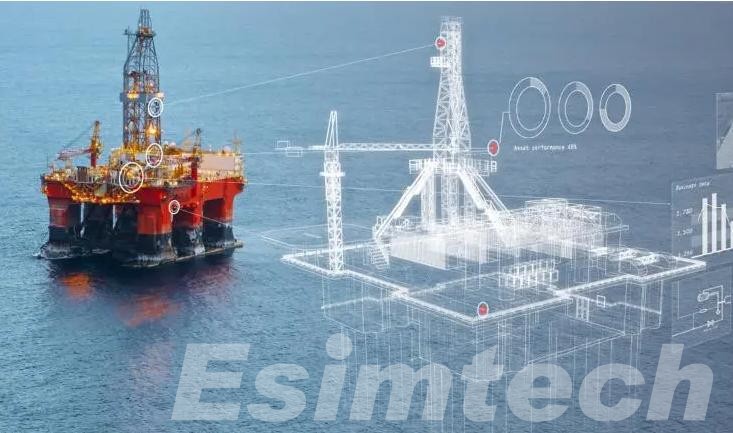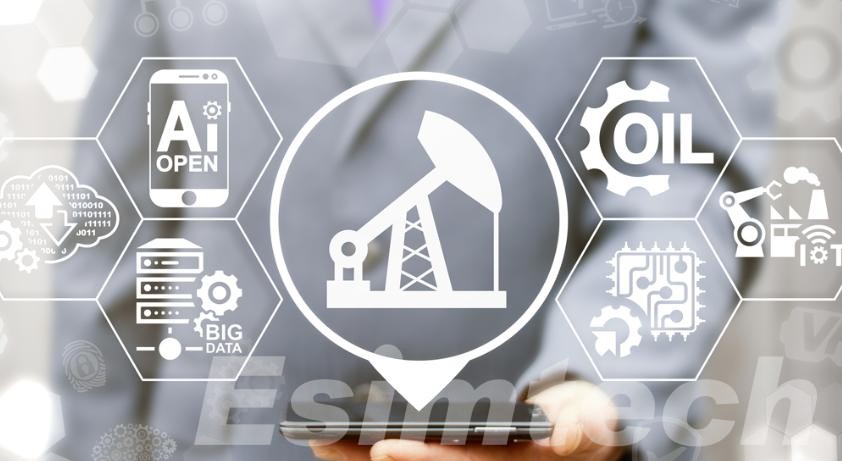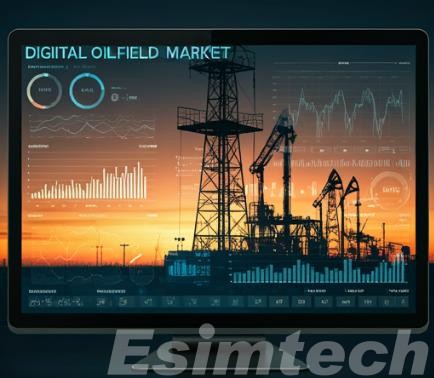The Rise of the Digital Oilfield: Revolutionizing Oil and Gas Operations
The oil and gas industry is undergoing a profound transformation, fueled by the rise of digital technologies that are enhancing operational efficiency, safety, and profitability. Known as the “digital oilfield,” this integration of cutting-edge technologies is revolutionizing how companies explore, extract, and manage hydrocarbon resources. In this article, we explore what the digital oilfield is, the key technologies driving its development, its benefits, and its projected market growth.

What is the Digital Oilfield?
The digital oilfield involves the integration of digital technologies to enhance and automate various oil and gas operations. This approach utilizes a range of advanced tools and techniques, including sensors, the Internet of Things (IoT), artificial intelligence (AI), machine learning (ML), data analytics, and cloud computing. Together, these technologies collect and analyze vast amounts of data in real-time.
By bridging the gap between the physical and digital aspects of oilfield operations, the digital oilfield connects machinery, sensors, and personnel through a unified platform. This enables real-time monitoring, predictive maintenance, remote operations, and automated decision-making, significantly improving the efficiency and safety of exploration, drilling, production, and distribution processes.
Key Components of a Digital Oilfield
- Data Integration: One of the primary goals of the digital oilfield is to unify data from various sources, such as drilling rigs, pipelines, reservoirs, and refineries, into a central digital platform. This creates a comprehensive view of the entire production process, providing valuable insights into performance, asset health, and potential risks.
- Real-time Monitoring: With the help of IoT sensors and automated systems, data is continuously collected and fed into monitoring tools that can track the status of equipment, wells, and pipelines in real-time. This enables operators to respond quickly to any operational anomalies or emergencies.
- Predictive Analytics and Automation: Beyond monitoring, the digital oilfield relies on predictive analytics powered by AI and machine learning. These tools can analyze historical and real-time data to forecast potential failures or inefficiencies before they occur. Automated workflows can then initiate corrective actions, such as adjusting production rates or scheduling maintenance, without the need for human intervention.
This smart integration of hardware and software components transforms oilfield operations from being reactive to predictive and proactive. It allows operators to identify and resolve issues long before they cause significant problems, reducing downtime, minimizing safety risks, and improving overall productivity.
Areas of Application in Oil and Gas Operations
- Exploration and Drilling: In exploration, the digital oilfield allows companies to analyze seismic data with greater precision, identifying optimal drilling locations more accurately. During drilling, automated systems combined with real-time analytics enhance drill bit performance, manage pressure levels, and adjust drilling speeds to boost overall efficiency.

- Production and Reservoir Management: Once production starts, the digital oilfield continuously monitors well performance and reservoir conditions, making real-time adjustments to optimize output. Predictive models assist in reservoir management by offering insights into how different extraction methods could impact long-term production, allowing for more informed, strategic planning.
- Maintenance and Asset Integrity: Digital oilfields utilize condition-based monitoring systems to track the health of machinery and equipment. Predictive maintenance strategies ensure components are serviced before they fail, extending the lifespan of critical assets and minimizing costly, unplanned shutdowns.
In essence, the digital oilfield goes beyond merely upgrading existing processes; it establishes a comprehensive, data-driven ecosystem where automation and smart technologies transform how oil and gas operations are managed. By turning data into actionable insights and enabling automated, real-time responses to operational challenges, the digital oilfield helps companies improve efficiency, lower operational risks, and stay competitive in a rapidly changing industry.
Key Technologies Driving the Digital Oilfield Revolution
The digital oilfield is powered by a range of cutting-edge technologies that work together to optimize oil and gas operations. These technologies enable real-time data collection, advanced analytics, automation, and remote management, revolutionizing traditional workflows. Below are the key technologies driving this digital transformation:
1. Internet of Things (IoT) and Smart Sensors
The Internet of Things (IoT) involves the deployment of interconnected devices and sensors throughout oilfield operations. These smart sensors collect and transmit data on various parameters such as pressure, temperature, and flow rates in real-time. This continuous monitoring allows operators to gain insights into equipment performance and environmental conditions, facilitating immediate action in case of anomalies. By harnessing IoT technology, oil and gas companies can improve operational efficiency, minimize downtime, and enhance safety through timely interventions.
2. Big Data Analytics
The oil and gas industry generates massive volumes of data from drilling, production, and other operational activities. Big data analytics enables companies to process and analyze this information to extract meaningful insights. Advanced analytics tools utilize algorithms to identify patterns, trends, and correlations that may not be visible through traditional analysis. By leveraging big data, operators can optimize drilling locations, forecast production rates, and enhance decision-making across various operational facets.

- Artificial Intelligence (AI) and Machine Learning (ML)
AI and ML technologies are crucial in automating decision-making processes and improving operational efficiency in the digital oilfield. These systems can quickly analyze complex datasets, detect patterns, and make predictions, all of which are essential for optimizing operations. For instance, AI-driven models can predict how a reservoir will respond to different extraction techniques, while machine learning algorithms help identify optimal drilling sites. AI also enhances safety by automatically identifying potential risks, such as equipment malfunctions or environmental hazards, before they occur.
4. Cloud Computing and Edge Computing
Cloud computing has transformed how data is stored, processed, and shared in the oil and gas industry. It allows companies to centralize their data storage and access it from any location, facilitating real-time collaboration across geographically dispersed teams. Cloud platforms also enable advanced data analytics by providing the necessary computational power to process large datasets efficiently. In parallel, edge computing complements cloud solutions by processing data closer to the source—on the oilfield itself—thereby reducing latency. This is especially critical for remote locations where real-time decision-making is essential, as it enables faster responses to operational issues.
- Digital Twin Technology

Digital twin technology involves creating a virtual replica of physical assets, processes, or systems in the oilfield. This dynamic model integrates real-time data from sensors and IoT devices to simulate operations accurately. Operators can use digital twins for predictive maintenance, scenario planning, and performance optimization. By visualizing how assets behave under various conditions, companies can make informed decisions that enhance efficiency and reduce risks.
7. Blockchain Technology
Though still emerging in the oil and gas sector, blockchain technology holds promise for enhancing transparency and security in operations. By providing a decentralized, immutable ledger, blockchain can facilitate secure transactions, track supply chain movements, and ensure compliance with regulatory requirements. This technology enhances data integrity and fosters trust among stakeholders, which is crucial in a complex industry with multiple partners.
Benefits of the Digital Oilfield in Oil and Gas Operations
The adoption of the digital oilfield brings a multitude of benefits that fundamentally enhance the efficiency and sustainability of oil and gas operations.
1. Increased Operational Efficiency
Digital technologies streamline workflows and eliminate redundancies, leading to improved operational efficiency. Real-time monitoring allows for quick identification of issues, enabling faster decision-making and minimizing downtime.
2. Enhanced Safety and Risk Management
Safety is paramount in the oil and gas sector. The digital oilfield improves safety by providing continuous monitoring of equipment and environmental conditions, allowing operators to detect potential hazards and respond proactively to prevent accidents.
3. Cost Reduction
Predictive analytics and automation significantly reduce maintenance costs by facilitating condition-based monitoring and timely interventions. This proactive approach prevents unplanned downtime and optimizes asset utilization, leading to overall cost savings.
4. Improved Reservoir Management
The digital oilfield enhances reservoir management through data-driven insights, enabling companies to optimize production techniques and maximize hydrocarbon recovery. This leads to more strategic drilling and extraction processes, ultimately improving returns on investment.
5. Sustainability and Environmental Compliance
By optimizing resource use and minimizing waste, the digital oilfield contributes to more sustainable operations. Advanced monitoring systems help ensure compliance with environmental regulations, reducing the ecological footprint of oil and gas activities.
In summary, the digital oilfield is a catalyst for transformative change, enhancing efficiency, safety, and sustainability throughout the oil and gas industry.
How Big is the Digital Oilfield Market?

The digital oilfield market is experiencing robust growth, reflecting the increasing adoption of digital technologies in the oil and gas sector. As of 2023, the global digital oilfield market was valued at approximately $28 billion and is projected to reach around $38 billion by 2028, with a compound annual growth rate (CAGR) of about 6.5% during this period.
This growth is driven by several factors, including the rising demand for energy, the need for enhanced operational efficiency, and the increasing focus on sustainability within the industry. Companies are increasingly investing in advanced technologies such as IoT, artificial intelligence, and big data analytics to optimize their operations and respond to the challenges of a dynamic market environment.
Key regions contributing to the growth of the digital oilfield market include North America, primarily due to its strong oil and gas sector, and the Middle East and Asia-Pacific regions, where significant oilfield developments and investments in technology are taking place. As the industry continues to evolve and embrace digital transformation, the digital oilfield market is expected to play a crucial role in shaping the future of energy production and management.
What’s Next?
The rise of the digital oilfield is reshaping the oil and gas industry, offering unprecedented opportunities for efficiency, innovation, and sustainability. By leveraging advanced technologies, companies can optimize operations, reduce costs, and improve decision-making. As the digital oilfield continues to evolve, it is poised to play a crucial role in meeting the world’s energy needs while minimizing environmental impact.

